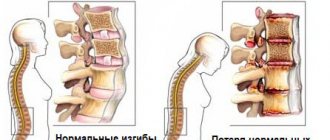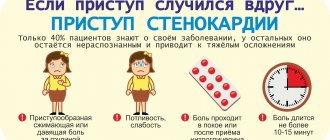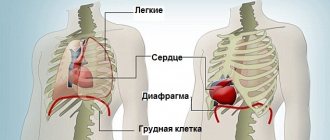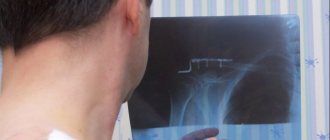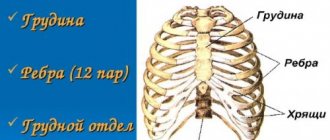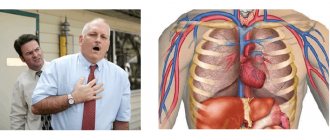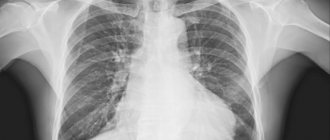Burning, squeezing and other unpleasant conditions localized in the chest are among the symptoms of many diseases, so when they appear, a person should first consult a doctor. Many organs from different body systems are localized in this area, and damage to each of them can be accompanied by a burning sensation.
To get rid of such unpleasant phenomena, you need to identify and eliminate the provoking factor. Given these circumstances, it is first necessary to conduct a thorough diagnosis.
What diseases provoke a burning sensation in the chest?
A burning sensation in the middle of the chest can indicate not only diseases of the sternum. In some cases, such unpleasant sensations are an “echo” of existing problems associated with the functioning of other organs.
Diseases of the liver and biliary tract
Pain in the chest may be associated with diseases of the liver and biliary tract . Since the liver is located in the right lower hypochondrium, any pain associated with poor functioning of this organ can “radiate” to the sternum, resulting in a burning sensation in the chest.
Diseases of the liver and biliary tract are accompanied by the following symptoms:
- unpleasant sensations in the form of pain and burning occur after eating. Especially after eating unhealthy foods such as fast food, processed foods, fried foods, sweet carbonated drinks;
- periodically there is a burning sensation in the sternum, accompanied by a dull pain;
- liver diseases provoke a burning sensation in the right side of the chest, and a burning sensation can also be localized on the right side of the neck and arm;
- the appearance of a dense yellow coating on the tongue indicates poor functioning of the biliary tract;
- an unpleasant bitter taste may appear in the mouth in the morning;
- the lower parts of the whites of the eyes, as well as the backs of the palms, turn yellowish;
Digestive tract problems
First of all, there may be a burning sensation in the sternum due to heartburn. Gastric juice irritates the walls of the esophagus, thereby causing discomfort. Heartburn is accompanied by a sharp burning sensation in the lower part of the chest.
Diseases such as pancreatitis, gastritis, stomach and duodenal ulcers, and intestinal colic are often also associated with a burning sensation in the chest. Also, the entry of foreign bodies into the stomach negatively affects sensations in the sternum.
Intercostal neuralgia
Occurs in conditions of pinching and subsequent inflammation of the nerves adjacent to the intercostal muscles.
Symptoms of intercostal neuralgia are accompanied by a strong burning sensation. The location of pain can be easily identified by self-palpation.
Unpleasant sensations in the chest intensify during breathing, coughing, bending and turning.
Pneumonia
A feeling of itching on the lungs (you want to cough, as if to “scratch” them) often signals the presence of respiratory tract diseases. Inflamed lungs (i.e. pneumonia) cause pain and burning in the chest.
Respiratory system dysfunction is accompanied by the following symptoms:
- increased body temperature;
- lack of appetite;
- the occurrence of nausea;
- cough accompanied by bloody sputum;
- rib pain;
- prostration;
- hard breath;
Complaint of a burning sensation in the sternum: the main causes
A burning sensation in the chest is a fairly common symptom of various diseases. This sensation can occur on the left or right side of the chest or in the middle. There are many organs located in the chest area, and it is not so easy to determine which of them has failed. This is why it is important to study the symptoms and causes of this condition.
Cause of burning and pain in the chest area
Digestive diseases
The most common cause of a burning sensation in the chest is increased acidity of gastric juice. During the digestion of food, the acidic contents of the stomach are thrown into the esophagus (reflux), burning its walls and causing irritation. The burning sensation does not stop, but only intensifies with each meal. It usually burns in the sternum area, right in the middle of the chest.
If burning and pain in the sternum begins in the morning on an empty stomach and disappears when eating, then the cause is the development of esophagitis. This disease of the esophagus is also accompanied by nausea, pain when swallowing solid food and a sensation of a foreign body in the throat. If such symptoms are detected, you should contact a gastroenterologist.
Burning and pain in the chest may be associated with diseases of the pancreas . In this case, patients complain of burning pain in the left hypochondrium. This condition develops due to spasms of the gastric wall and the development of duodenitis (inflammation of the duodenum), which is caused by the proliferation of bacteria.
Similar symptoms are accompanied by colitis, in which the intestinal contents are thrown back into the stomach, that is, pain and burning also occur in the left hypochondrium.
Burning and pain can also be signs of gastritis or a stomach ulcer, in which case the discomfort may be localized in the middle of the chest.
Diseases of the cardiovascular system
Patients with pathologies of the heart and blood vessels . They often complain that there is a burning sensation in the chest. This symptom is observed when:
- Myocarditis;
- Valve insufficiency;
- Development of myocardial infarction;
- Angina pectoris;
- Rheumatism;
- TELA
If pain and burning sensations occur in the middle of the sternum and are not relieved by a solution of baking soda, but disappear when taking nitroglycerin, then the help of a cardiologist is needed.
Burning and pain in the right side of the chest
They are often a sign of diseases of the respiratory system. As a rule, the burning sensation is accompanied by fever and cough . accumulation of fluid in the pleural cavity.
It is the involvement of the pleura in the pathological process that causes the burning sensation in the chest.
If pain and burning is accompanied by purulent sputum, the presence of an abscess or gangrenous lesion of the lung tissue can be assumed.
A severe burning sensation on the right side of the chest combined with a strong cough are signs of the development of pneumonia, and the symptoms described above with a sharp increase in temperature to 40 degrees and pronounced leukocytosis in a blood test indicate bilateral pneumonia. An x-ray will help confirm the diagnosis of pneumonia (and the cause of the symptom).
Osteochondrosis
Burning and aching pain in the heart are common signs of osteochondrosis of the thoracic spine. In this disease, heart medications do not improve, but rather worsen the general condition. The cardiogram for osteochondrosis is usually normal.
Manifestations of the disease are as follows:
- Discomfort when lying on one side for a long time;
- Sensation of squeezing in the chest;
- The appearance of pain in the left side of the chest, increasing with physical activity;
- The appearance of pain in the chest and between the shoulder blades while walking;
- Erectile dysfunction in men;
- Persistent feeling of coldness in the legs;
- The patient complains of a burning sensation in the chest.
Mental disorders
A burning sensation in the chest may be a sign of mental illness. Thus, with Parkinson's disease, the patient feels pain and heat in the back of the chest, and Alzheimer's disease is accompanied by similar sensations, but in the upper parts of the chest.
The presence of aggressive behavior, combined with a burning sensation in the sternum, is a characteristic feature of the depressive syndrome.
Special, acute conditions of burning in the chest
Periodically occurring sharp pain in the chest, accompanied by a strong burning sensation, often signals possible serious heart problems .
Such syndromes are a sufficient argument for a visit to a cardiologist. A negligent attitude towards your health can result in a sad outcome.
Contrary to popular belief, the heart is not located on the left side of the chest, but almost in the very center, only slightly shifted to the left side. Accordingly, any pain sensations emanating from the heart muscle respond directly to the middle of the chest .
The above syndromes are characteristic of diseases such as angina pectoris, myocardial infarction and myocarditis.
Angina pectoris
This is a pathology that occurs due to poor oxygen supply to the heart muscle. One of the forms of coronary heart disease. Angina pectoris is directly related to deterioration of blood circulation; this disease cannot be ignored. Atherosclerotic plaques “clog” the arteries, resulting in a deterioration in the blood supply to internal organs.
Men are at least twice as susceptible to this pathology as women. The average age of onset of angina is 51 years .
Most often, the emerging pathology reveals itself during physical exercise, after severe nervous strain, or during heavy physical labor.
What other diseases and conditions can cause a burning sensation in the chest?
Unpleasant sensations in the form of a burning sensation in the chest can also be felt after intense physical activity .
A crack in the ribs or a severe bruise of the chest may be accompanied by discomfort, pain and burning in the chest.
Rheumatism, hiatus hernia, herpes zoster is an incomplete list of pathologies, accompanied by a burning sensation in the middle of the chest.
Unpleasant sensations in the chest due to gastrointestinal diseases
Most pathologies of the gastrointestinal tract, in their symptoms, may resemble the course of any other pathological processes, in particular, various types of heart diseases. In this regard, a person may experience chest pain, but the reasons that caused the pain syndrome are not related to cardiac dysfunction. The main diseases of the gastrointestinal tract that can cause pain in the thoracic region include:
- heartburn. The occurrence of this phenomenon is associated with the reflux of stomach contents into the esophagus, which leads to irritation of its walls. In this case, a person experiences a burning sensation in the throat and sternum. Heartburn can occur after eating or even on an empty stomach. In some cases, heartburn may cause a dry cough. Generally, discomfort caused by irritation of the esophagus lasts from several minutes to one hour;
- A burning sensation in the chest and throat is often caused by diseases of the gastrointestinal tract such as pancreatitis, hepatitis and cholecystitis. Various pathologies affecting the biliary tract, spleen and kidneys also have similar symptoms.
Additional symptoms and chest burning
Sometimes, in addition to the obvious burning sensation in the chest, other symptoms of pathologies appear. Together, they can signal the occurrence of various ailments:
- if the pain radiates in the middle between the shoulder blades , to the left arm or to the left side of the jaw - this is a clear signal about problems with the heart;
- periodic attacks of pain , burning and compression in the sternum are also symptoms of various heart diseases;
- a burning sensation in the right side of the chest and lower hypochondrium indicates the presence of pathologies associated with the functioning of the liver, biliary tract, and duodenum;
- angina pectoris is characterized by pain in the sternum after intense exercise or walking;
- a burning sensation in the chest area with a pronounced cough may indicate the development of bronchitis or pneumonia;
- if discomfort occurs during physically strenuous work or walking , this is a clear sign of osteochondrosis.
Associated symptoms
Pleurisy
The burning sensation is usually not isolated. You should pay attention to other symptoms and features.
- Localization of discomfort behind the sternum on the left is a sign of the development of cardiac pathology.
- The connection of burning with breathing, the appearance of cough, shortness of breath, sputum, hemoptysis - there is probably a pathology of the lungs, bronchi or pleura.
- The appearance or intensification of unpleasant sensations when walking or running - a symptom appears if osteochondrosis or other pathological processes occur in the thoracic spine.
- Connection with food intake, the appearance of heartburn in the form of a burning sensation behind the sternum is a sign of damage to the organs of the digestive system, namely the esophagus and stomach.
- Localization of burning in the area of the right chest is a manifestation of pathological processes in the liver and structures of the biliary tract.
- The appearance of discomfort after physical or emotional stress, which may mean angina pectoris. “Pectoris pectoris” - as if it squeezes the heart, but can let go when it is alone.
- The burning sensation is accompanied by general intoxication with increased body temperature, deterioration of health, weakness, loss of appetite - it may indicate an inflammatory process of infectious origin, which is localized in the lungs or soft tissues of the chest.
The symptoms of burning pain in the sternum and burning help to make an initial conclusion, after which the doctor prescribes a targeted objective examination and appropriate treatment.
What to do, what examinations need to be completed
Of course, if you experience periodic discomfort in the chest, you need to contact a qualified therapist, cardiologist, pulmonologist and undergo a prescribed examination. It will help clarify the diagnosis and identify the causes of pain.
Diagnosis of the disease begins with donating blood for biochemistry and general analysis . The doctor must listen to the work of the lungs with a stethoscope, after which it will be necessary to do fluorography of the chest.
You may need to be tested for tuberculosis . An ultrasound will also be required .
After receiving and analyzing the results, the doctor may prescribe individual additional studies.
Which doctor should I contact?
First, you should contact a therapist , who will refer you for an examination. At the same time, it is worth visiting a pulmonologist and cardiologist . After ruling out possible problems with the heart and lungs, you need to undergo examination by a gastroenterologist .
You must come to your appointment with the results of an ultrasound scan of the liver and biliary tract, stomach and duodenum.
Which doctor should I contact if I have a burning sensation in my chest?
Regular repetitions of this symptom are a reason to contact a therapist. He will conduct an examination, collect anamnesis, ask questions that interest him - and either prescribe treatment or refer him to:
- gastroenterologist - if gastrointestinal diseases are suspected;
- orthopedist - if osteochondrosis is suspected;
- neurologist - if osteochondrosis is suspected;
- cardiologist - if you suspect diseases of the cardiovascular system.
They, in turn, will prescribe diagnostic tests to make an accurate diagnosis.
How to quickly help yourself: actions for a burning sensation in the chest
If there is a clear feeling of discomfort in the chest, you should not rely on introspection. A visit to the doctor should not be put on hold to avoid possible complications. But if pain takes you by surprise, you can take some measures to relieve the symptoms of pathological processes.
Here are some of them:
- if the pain is localized in the left side of the chest, first of all, you need to calm down, take a comfortable position and rest . a Nitroglycerin tablet according to the instructions , it will relieve pain in case of angina attacks. If it becomes difficult to breathe, and the pain turns into a sharp form, call a doctor immediately;
- discomfort in the middle of the chest during or after eating is a sign of heartburn. To get rid of it, just take a weak solution of water and soda ;
- A burning sensation in the sternum during colds is not uncommon. You can get rid of it only after completing a course of antibiotic therapy. You cannot prescribe antibiotics yourself, since only a doctor can choose the right medicine and select the required dosage. However, your condition can be alleviated by taking any non-steroidal anti-inflammatory drug (for example, Ibuprofen, Diclofinac );
- allergic processes can also be associated with an unpleasant condition in the chest area. Characterized by constant itching and a burning sensation in the chest. Taking any antihistamine, such as Zodak or Suprastin, .
Symptoms
In this case, it is impossible to identify a general clinical picture, since this is a symptom of a nonspecific nature.
Pain in the chest located in the middle may be a sign of upper respiratory tract disease. In this case, influenza and acute respiratory infection cannot be ruled out either. The following clinical manifestations may be observed:
- low-grade fever, as the pathological process worsens, high body temperature;
- headache, drowsiness;
- loss of appetite;
- sore throat, sore throat;
- labored breathing;
- cough;
- runny nose;
- feeling of aching in bones and muscles;
- weakness.
However, you need to understand that these clinical manifestations may be a sign of a pathological process of another nature, so you need to consult a doctor for medical help and not self-medicate.
A burning sensation behind the sternum on the left side may be a sign of a disease such as “angina pectoris,” which is characterized by the following clinical picture:
- a feeling of pressure, heaviness and tightness in the chest;
- the pain is localized on the left side, can radiate to the scapula area, sometimes to the left arm right down to the fingertips, and can intensify with deep breathing;
- unstable blood pressure;
- rapid pulse;
- increased cold sweating;
- cough;
- Changing body position does not reduce the intensity of pain.
Symptoms of angina pectoris
The manifestation of this symptom during a heart attack is also no exception. Burning and pain behind the sternum in this case can be supplemented by the following clinical picture:
- heart rhythm disturbance;
- dizziness;
- high blood pressure;
- sharp pain in the heart, which can manifest itself both during physical activity and at rest. A distinctive feature is that the pain does not go away after taking nitroglycerin;
- pain radiates to the left shoulder blade and arm;
- cold sweating;
- dyspnea.
In some cases, a burning sensation behind the sternum may be a sign of the clinical picture of myocarditis, which is characterized by the following manifestations:
- dyspnea;
- low-grade fever;
- swelling in the lower extremities;
- weakness, increased fatigue;
- frequent changes in blood pressure;
- irritability;
- sleep cycle disturbance;
- attacks of angina.
It should also be noted that with this disease, the clinical picture appears periodically, and at the initial stage of development, symptoms may be completely absent. As the pathological process worsens, the intensity of the symptoms becomes more pronounced.
The appearance of such a symptom in some gastroenterological diseases cannot be ruled out. In such cases, patients may complain of:
- pain in the stomach, which may intensify after eating or, conversely, during fasting (so-called “hunger pains”);
- deterioration or complete lack of appetite, which may result in sudden weight loss;
- changes in stool frequency and consistency;
- the presence of pathological impurities in the stool - blood, mucus, pus;
- dyspeptic symptoms - heartburn, belching with an unpleasant odor;
- flatulence, rumbling in the stomach;
- unpleasant taste in the mouth;
- low-grade body temperature (in some cases).
With osteochondrosis, burning and pain behind the sternum can be characterized by the following symptoms:
- a burning sensation behind the sternum may be accompanied by pain, which intensifies with physical exertion and physical activity;
- crunch in the neck;
- dizziness;
- headaches for no apparent reason;
- fatigue, increased fatigue;
- pain in the neck and back of the head;
- numbness of the limbs, feeling of coldness in the fingers and toes;
- difficulty breathing, feeling of heaviness in the chest;
- pain may radiate under the shoulder blades;
- disorders of the gastrointestinal tract - attacks of diarrhea, bloating, nausea, loss of appetite.
As the pathological process worsens, burning and pain in the chest area can bother the patient even at rest, so at the first signs of illness you should immediately seek medical help.
Osteocondritis of the spine
If the cause of such a symptom is an oncological process, then the following symptoms may occur:
- difficulty breathing, sensation of a foreign body in the throat;
- general deterioration of health;
- weakness, decreased performance;
- irritability;
- headache;
- dull, pressing pain in the chest area, which gradually increases;
- weight loss for no apparent reason;
- discharge from the nipples of the mammary glands;
- enlargement of one mammary gland, pain on palpation;
- in women - menstrual irregularities.
It should be noted that this is only an approximate clinical picture; the symptoms of the oncological process will depend on the underlying factor and the localization of the pathological process.
Preventing burning in the chest
To avoid possible complications, you must:
- Firstly, promptly and competently treat any inflammatory processes in the body.
- Secondly, you should avoid eating fast food, alcoholic beverages, sweets, fried, smoked and fatty foods. Physical activity must be present in your schedule. Doing fitness, dancing, or swimming in the pool can protect you from many different diseases.
- Thirdly, be sure to get enough sleep. You need to sleep at least seven hours a day. Although the norm of sleep is individual for everyone. Avoid stressful situations and nervous tension. Try to be calmer about everything that happens around you. Save your nerves and your health.
Eat more fruits and walk in the fresh air. In winter, you can add a complex of vitamins and minerals .
Try to monitor your health and visit a doctor on time if necessary.
